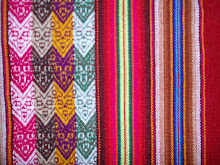The ceremonies are followed by parties (of course--this is Japan!). If you want to see beautiful native ceremonial dress, this is one festival day not to be missed.
Following 成人の日 comes the 鳥追い祭り Torioi Matsuri that brings dear Nakanojo some fame. This is an old festival dating back to Japan's early Edo period. All the celebrations begin before sunrise with the どんど焼き dondo yaki a huge bonfire into which the だるま daruma faces of the previous year are thrown and burned or bad luck with ensue. We also roast what appear to be big white marshmallows on tree limbs...but are in reality hard little balls of steamed rice, so if you're expecting to sink your teeth into a nice, hot, sweet, gooey marshmallow, you are in for a very sorry surprise. Instead, your teeth crunch through the tough outer shell that formed on the rice ball in the yaki and then you can barely chew the rice ball due to the intense stickiness and thick texture. Perhaps these are leftovers from the New Year's もち mochi rice cakes that were pounded out of stick rice put in a wooden container by heavy (very heavy!) wooden mallets. Many actually choke and die on this もち during each New Year.

Okay, so the だるま are those funky little creatures that are said to bring good luck, and have two eyes that are to be colored in. The first eye is colored when one begins a new endeavor, and the other when that goal had been realized. You are not to keep that doll into the New Year, however, so they are burned in the superstition that all the hard work will be somehow undone.
Then we chase the rice balls with cups of 甘酒 amazaki a sweet sake drink that's warm and perhaps akin to our hot chocolate...no chocolate, and although they say the alcohol, when heated, burns out, that is just not true, having started all three of my 鳥追い祭り celebrations out with quite the buzz by only 6 a.m. Ay, those were the days...
Then the fun begins at about 11 in the morning. The BIG Edo-period 和太鼓 wadaiko drums are pulled through town by the local young people (late teens/early 20s) dressed in festival gear. They stop at various points on the main streets in town (all closed off for the day to any traffic) and are beaten. In order to beat the taiko drums, you have to engage your entire body in the swinging of the drumstick, thus requiring quite a workout.

The purpose, you may ask? To chase the bad birds and spirits away in order to ensure a fruitful harvest in the New Year. Nakanojo is located in a rural, agricultural area of Japan--rice paddies everywhere. The country's largest crops of cabbage were just up the road from me, in Tsumagoi. We didn't want any bad birds ruining the fruits of labor! Let me just say that the beating of those drums would scare just about anything away, while perhaps awakening the dead in the process.
The unarguably best, most fun aspect of this festival, however, is the みかん mikan clementine orange throw. At various established stations throughout the town, mikan are thrown in a mad frenzy to the crowd below. Having been both at the receiving end, with my big plastic bag wide open to catch all the mikan I could in hopes I got some with a good prize attached (some had town sponsors giving away prizes from their stores--the best I got was a rug for my cold kitchen floor) and enough mikan to sustain me for the next few weeks so I didn't have to buy any at the store (which were, of course, at rock bottom prices because there was no demand--everyone got their oranges at the festival throw for free!) and the throwing end, when I could peg current and ex-students and co-workers and not feel guilty in the least, I can honestly say I preferred being the peg-ger than the peg-ee.
This festival continues for 10 hours, until 9:00 at night, at which time the drums are brought back to their various neighborhood stations and parked until the 夏祭り, the summer festival, and then the partying ensues. I was adopted by one specific neighborhood in the town, so I would go with those guys to a big dinner, a lot of drinking (of course, having been drinking since 4 or 5 a.m., this was for the heartiest...as I have full recollection of all of this, this serves as a testament as to how I spent my early 20s) followed by karaoke and, for the strongest of souls, ラメン ramen at about 2 or so in the morning.

I cannot say I have experienced anything at all like this outside of Japan, and truly doubt I ever will. La tomatina de Buñol, Spain is certainly inviting, but as that is more of a free-for-all, it is very limited time-wise, and it is incomparable in that it lacks the ceremonious control and rules that create an omnipresent undercurrent in anything Japanese.

That sounds like fun. Rach loves everything Japanese and especially Raman which I ate enough of in college to never ever want to touch again. Stuff's cheap though.
ResponderEliminarI've missed you too just wasn't feeling up to writing. Sometimes things just go dark in my mind. I hate when that happens.
It is so hard for me to believe that over 10 years have now passed since I lived there. The memories of times had, friends made, etc., etc., etc. are so fresh in my memory. Better to write them now while I still remember them! JA!
ResponderEliminarGlad to see you back, Z...be well...